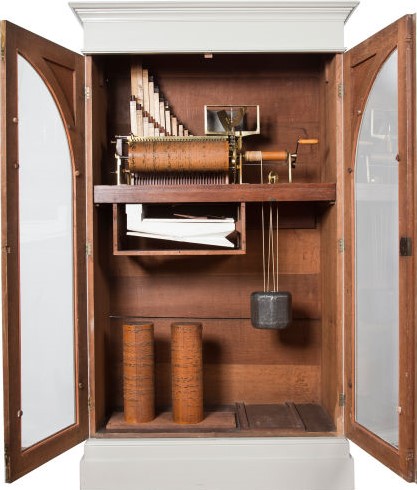I don’t know about you, but the current news cycle has me going back and forth between fiery rage and hide-in-bed anxiety, so I decided to write about something everyone can agree is wonderful: chocolate. Belgium is known for it’s high quality chocolate, despite not being able to grow cocoa, and that’s because it was a Belgian who first perfected the blend of cocoa solids, cocoa butter, sugar, and milk that became the creamy, bitter-sweet confection we are all addicted to today. Naturally, as a lifelong chocoholic, I couldn’t pass up the chance to spend a full day visiting the best that Brussels has to offer. I pulled a basic itinerary from another blogger, and modified it a little to suit my own needs. I also made a couple of extra stops in the days afterward to round out my Belgian Chocolate Experience. Get a napkin, because you may drool.
I’m not going to go into the history of chocolate (it’s fascinating), nor am I going to give detailed information on the chocolate flavor profiles (just as complex as wine). I’m also not going to do a lot of explaining of basic chocolate vocabulary. I think most of you can still enjoy these descriptions without that, but if you are curious to learn more about chocolate, I suggest you check out any of the websites of the chocolateries I visited in Belgium.
After each shop and description of individual candies, I’ve given my rating out of 5 stars and my recommendations for what to try. You can decide which shops are most appealing to you to make your own Brussels chocolate tour. Nearly all of them have multiple locations within a walking radius in Sablon, but those that are a little farther out are well worth the bus ride.
A note about being a tourist: When I read about chocolate touring in Brussels, I was warned that shops did not give out samples, but that single pieces would be about 1-2€. I was prepared for the price of fine chocolate, but I was delighted to find it wasn’t actually true. Nearly every shop I went into was happy to let me try one or more of their flavors if I stopped and talked about it with them. I’m guessing that other tourists have found the shops to be sample stingy because they want to go in and get free chocolate without engaging anyone socially. For me, chatting with the staff was half the joy of this chocolate self-tour! They are friendly and very knowledgeable about the history of chocolate and of their own shop. I also found that most places were very reasonably priced if you were willing to have your pieces in a bag, rather than a fancy box.
Neuhaus

160 years ago, Jean Neuhaus (depicted in chocolate to the right) discovered the magical combination of ingredients that has lead to every chocolate confection and candy bar you’ve ever enjoyed. His chocolaterie is easily the most famous in the world, and it was my first stop.
Best Truffle in the World: No really, it won the award. It was given to me as a sample. I wouldn’t say it’s the very best chocolate I’ve ever eaten but I think it might be the epitome of “truffle”. The chocolate was not too bitter, not too tart, not too sweet, just the Goldilocks zone of chocolate and cream, dusted with cocoa powder. Simple and elegant.
Irrésistibles Coffee: Everyone in Belgium has ganaches, pralines, and truffles out the wazoo, but Neuhaus is the only place you can find the “Irresistables”. These little triangular gems are made with a base of nougatine (a crispy caramelized sugar), filled with cream or ganache, and enrobed in chocolate. I has the coffee ganache flavor. The coffee is very subtle, the filing is quite smooth, and the nougatine is delightfully crunchy and caramelly.
Hazelnut Creme Cone: The cones are “just filling”, held together with a gold foil cone instead of a chocolate shell. The hazelnut flavor was creamy and smooth with tiny bits of nut, not too sweet and good balance of chocolate, cream and hazelnut flavors. I could eat a dozen. In fact, I went back another day and got more because these were some of my favorite treats from the whole tour!
4 stars: The cones are tantalizing, and the Irrisistables are so unique. Plus, it is the oldest chocolaterie in the world.
Mary
Mary Delluc was the first female chocolatier in Belgium. She also designed the boxes of silk back in the day, and though they use paper now it’s still her design.

Champagne Truffle: The champagne flavor is clear and the texture contrast of the brittle chocolate outside and very soft creamy inside is nice. It was a little sweet for my personal tastes.
Earl Grey Ganache: There is no bad chocolate here, but it’s harder to judge the middle players after eating the best. I can’t really taste the bergamot flavor here. It’s a pleasant chocolate, but just chocolate. It’s disappointing because the truffles are good.

Violet Ganache: The flavor is subtle and the flower is more of an aftertaste. At first I thought it wasn’t there but as the chocolate left my tongue the violet became more obvious. I think violet tastes a bit like bubble gum. I noticed this when I tried violet liquor some time ago. The chocolate is good quality, the ganache is very smooth.
Champagne Rose Truffle: This is made with ruby chocolate, which was just introduced to the chocolate world one year ago in 2017 by Swiss chocolatiers at Barry Callebaut. The champagne flavor comes through strong. The powdered sugar exterior is a bit sweet, but the overall flavor is more mild cleanly chocolate. It was my favorite at this shop.
3 stars: Her chocolates aren’t my favorite, but it’s worth stopping by for the history and the champagne truffles.
Dandoy
Dandoy isn’t a chocolaterie, it’s a waffle shop. Waffles: the other confection Belgium is famous for. I didn’t know, but there are different types of Belgian waffle. I tried the Leige style with stracciatella ice cream. It was more chocolate chip than stracciatella, but still good.

The waffles are magically caramel on the outside. It’s as if a thin crispy later of sugar was caramelized. On the inside the Leige waffle is dense and bread-like, though think sweet bread like a cinnamon roll. Creamy ice cream is the best topping choice since it breaks up the sugar with fat.
Be careful if you order take out. They’re really serious about it, and won’t let take out orderers sit at the tables outside. If you want a table, you must request a seat and order from your waiter, not from the counter. The cost is the same.
4 stars: You have to try the waffles in Belgium, you might as well go for the famous name.
Chocoholic
I stopped to take pics of the tool shaped chocolate. Found …other… shapes. This shop isn’t anything to write about flavor-wise. The chocolate is mid-range and the flavors are unimaginative. It is purely a novelty shapes shop.
1 star: Don’t bother.
Pierre Marcolini
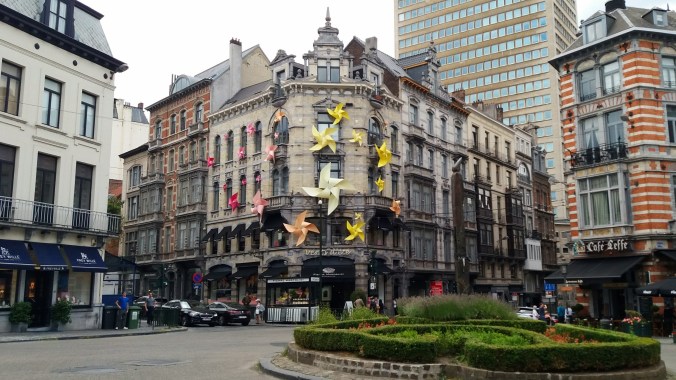 While I was interrogating the staff about their chocolate it became apparent they were only selling boxes (8 piece minimum). When I asked about the possibility of only buying a few pieces, I was sent upstairs to a little dining area. Although their chocolates focus mainly on single origin, bean to bar flavors, they do have a signature dessert line called the “Desir” which comes in a variety of flavors from white to dark chocolate and passing through a range of fruit and nut compliments.
While I was interrogating the staff about their chocolate it became apparent they were only selling boxes (8 piece minimum). When I asked about the possibility of only buying a few pieces, I was sent upstairs to a little dining area. Although their chocolates focus mainly on single origin, bean to bar flavors, they do have a signature dessert line called the “Desir” which comes in a variety of flavors from white to dark chocolate and passing through a range of fruit and nut compliments.
 Desir Noisette: I felt I had died and gone to heaven. The desert starts with a cookie base, followed by a hazelnut mousse filling, the center of which nestled a jewel of custard and caramel, coated in more chocolate and caramel.
Desir Noisette: I felt I had died and gone to heaven. The desert starts with a cookie base, followed by a hazelnut mousse filling, the center of which nestled a jewel of custard and caramel, coated in more chocolate and caramel.
I talked with the staff about my chocolate loves, and my plans for the day. I told them that chocolate and hazelnut was my all time favorite flavor combination, and the waiter gave me three hazelnut pieces to try. ❤ I don’t know their names, so I can only describe them by shape.

Round: The chocolate is very intense and a little bitter. The texture is dense with crunchy bits, probably a praline.
Square: It is sweet and very crispy. Almost like many thin layers of sugar or dough. The hazelnut flavor is strong, while the chocolate flavor is lighter.
Oval: Similar in intensity and flavor to the square, but with a gooey later of liquid salted caramel in the center. Just what it needed to balance the sweet and crunchy. It is the clear winner.
5 stars: I can’t imagine not liking anything there, but make time to sample a Desir, you will not regret it.
Laurent Gerbaud
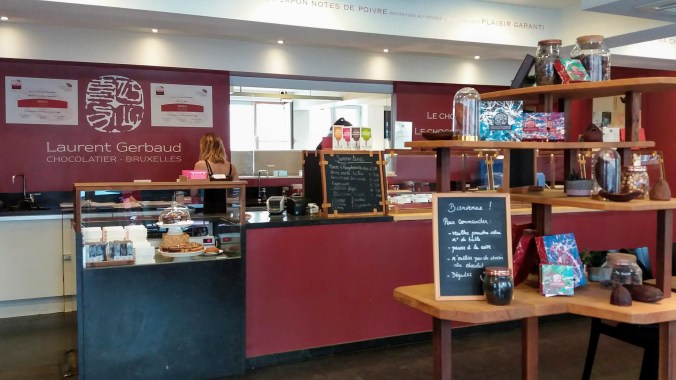 This shop is a little far out of the way but it is 100% worth the detour. It is a beans to bar production which means they actually make the chocolate from scratch. Most places buy chocolate from a bulk supplier and then add their own flavors. A few more places in Belgium are moving away from the couverture and into the beans to bar. My top 3 picks in Belgium are all bean to bar makers. Laurent Gerbaud is one of them.
This shop is a little far out of the way but it is 100% worth the detour. It is a beans to bar production which means they actually make the chocolate from scratch. Most places buy chocolate from a bulk supplier and then add their own flavors. A few more places in Belgium are moving away from the couverture and into the beans to bar. My top 3 picks in Belgium are all bean to bar makers. Laurent Gerbaud is one of them.
In addition to making their own chocolate, their fillings are incredibly creative and diverse. Most other chocolatiers here have the same flavors, each shop having maybe one or two unique twists, but Laurent Gerbaud goes all over the flavor map! I love it!
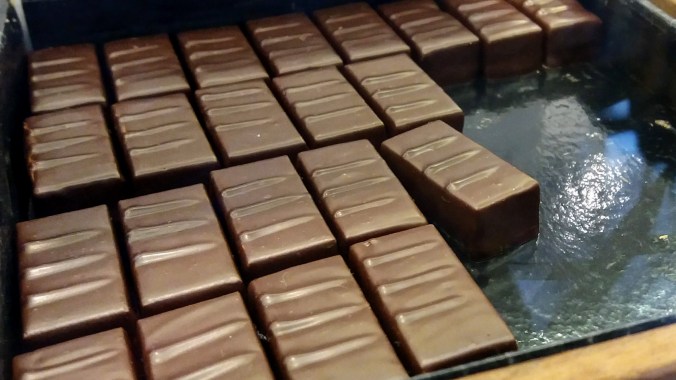 Black Olive Ganache: This award winning flavor was given to me as a sample. I probably wouldn’t have bought it just to find out, but they were excited to show off. It’s not as bad as it sounds. The filling evoked raisin and anise notes as my brain tried to reconcile chocolate and olive. I did have some cognitive dissonance as my palate refused to accept the blend. The second bite was smoother. Since I’m not really a fan of anise or raisin it wasn’t a winner for me, but neither did I feel the need to brush my teeth afterward. It went a long way toward showing me the skill of the makers.
Black Olive Ganache: This award winning flavor was given to me as a sample. I probably wouldn’t have bought it just to find out, but they were excited to show off. It’s not as bad as it sounds. The filling evoked raisin and anise notes as my brain tried to reconcile chocolate and olive. I did have some cognitive dissonance as my palate refused to accept the blend. The second bite was smoother. Since I’m not really a fan of anise or raisin it wasn’t a winner for me, but neither did I feel the need to brush my teeth afterward. It went a long way toward showing me the skill of the makers.
Candied lemon peel: I’m used to candied fruit having more sticky chewy and this one seemed a bit dry for my taste. The lemon flavor is solid, no acidity and not overly sweet, and the chocolate is great, but the texture is a little odd.
Ginger praline: A milk chocolate filling that was light and creamy. There were candied ginger bits for added texture. The gigner was prominent but balanced.
Sesame praline: Stunning! It’s like the best halva in amazing chocolate. I could eat it by the pound. The toasting flavor comes through, there’s a crispy texture from the sugar, and the chocolate just glides in to the mix.
Marzipan: Good crystalized texture, not too sweet, nice blend with the dark, rich chocolate.
Chai ganache: Good balance of flavors, playing well but not overpowering the chocolate. It’s a savory chai which is almost like a sweet curry. I actually thought it WAS the curry at first, but the real curry had more heat.
Curry ganache: Nice spice blend, similar to the chai but with an added bonus of heat. Like everything here it’s well balanced between chocolate and infusion and sweetness.

5 stars: Even the flavor I would not have imagined was well done. Things that are traditionally sweet are still only lightly sweet. They don’t need to use too much sugar to cover sad flavors because their flavors are amazing! Excellent ganache infusions and a truly magical sesame praline!
Corné Port Royal:
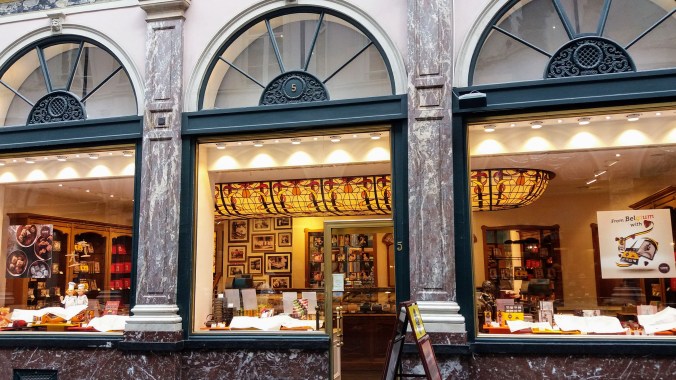 Pistachio Marzipan: So sweet! Even with the dark exterior. The almond flavor was ok, but the pistachio was not noticeable.
Pistachio Marzipan: So sweet! Even with the dark exterior. The almond flavor was ok, but the pistachio was not noticeable.
 Manon Sucre Vanilla: This shop is famous for inventing this particular confection, although other shops make and sell it now, too. It is so so so sweet. Nougat creme and nuts in white chocolate. It’s like someone took divinity and added white chocolate and whipped cream. Not… bad? Just so much sugar! I think the filling would have been great as a contrast to a dark, bitter exterior but only vanilla and coffee were on offer.
Manon Sucre Vanilla: This shop is famous for inventing this particular confection, although other shops make and sell it now, too. It is so so so sweet. Nougat creme and nuts in white chocolate. It’s like someone took divinity and added white chocolate and whipped cream. Not… bad? Just so much sugar! I think the filling would have been great as a contrast to a dark, bitter exterior but only vanilla and coffee were on offer.
Ganache Violette: I was disillusioned with this shop by the time I tasted this one, and really only did so to compare it to Mary’s violet ganache. Here the chocolate is more tart/citrusy, where Mary is balanced, the ganache is thick where Mary’s is lighter, and although the final taste in Mary’s was more of an after taste, here it feels overpowered by bitter chocolate and extra sugar.
White chocolate speculoos praline: It was better than the Manon and the marzipan, but still quite sweet. Not a unique flavor, so I’d say just try the speculoos praline elsewhere if you’re curious.
1 star: Sugar, sugar, sugar. Seriously, I don’t know how this place is on the famous list. The white and milk chocolates are overly sweet, the special flavors are not present or are overpowered. Disappointing. Skip it.
Mathilde
 Another “historical” stop. The dark chocolate here is a little on the fruity/sour side. Some people like that in a dark chocolate, I prefer the earthy flavors. The chocolate squares came with things like pop rocks, m&ms, or artificial fruit flavored dots. The chocolate bonbon balls were uninspired and bland flavors.
Another “historical” stop. The dark chocolate here is a little on the fruity/sour side. Some people like that in a dark chocolate, I prefer the earthy flavors. The chocolate squares came with things like pop rocks, m&ms, or artificial fruit flavored dots. The chocolate bonbon balls were uninspired and bland flavors.
Anywhere but Brussels, I’d call this good mid-range chocolate, but it’s much to expensive for it’s quality. 4.9€ per 100g, and the shop was one of two that had a minimum I liked the samples but those were simple chocolate squares. I ended up buying more novelty flavors and some of the bonbon balls to fill out the 100g… I was frankly disappointed.
2 stars: Perhaps their liquors, spreads and vinegars are more impressive, but as for chocolate? Skip it.
Elizabeth

Bay leaf / Laurier groseilles: The flavor is very subtle. The chocolate is dominant, and the filling is very smooth. Overall, it is rich and earthy with a pleasant bitterness.
Black cardamom /ganache cardamone: This one had a strong fruity flavor like berry? No sign of cardamom. It tastes good… but what flavor is it? I should be able to tell.
Jasmine ganache: Why can’t I tell what flavor it is when it’s in my mouth? I know what these things are supposed to taste like. Again more tart and citrusy, maybe a little earthy, but not clearly recognizable as floral.
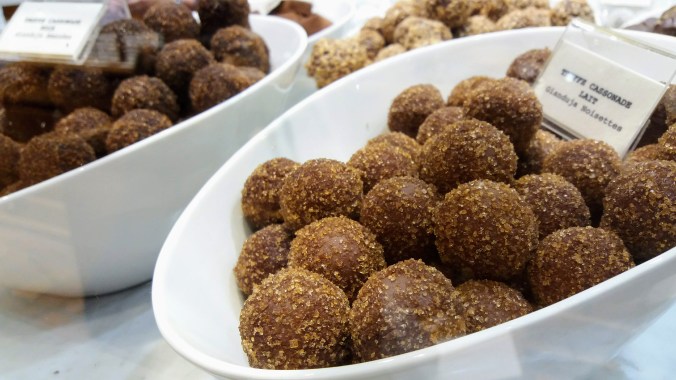
Orange Fleur de Sel: It is sweeter with a milk chocolate exterior, less acidic, probably orange peel. I can find the orange but it is very very faint. The fleur de sel is more a suggestion than a flavor. It tastes good, but not especially like what it’s supposed to taste like.
Chocolate truffle (sample): Delicious and rich, it has the perfect sweetness with a light crunch from a layer of cookie.
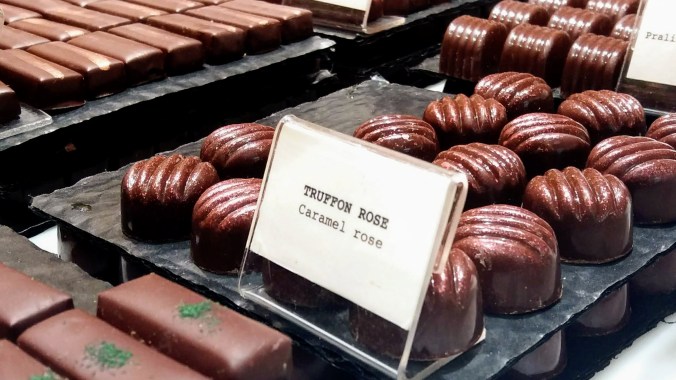
Caramel rose / truffon rose: I ate this last and it blew my socks off! Liquid caramel, buttery and with the edge of bitterness that I like in caramels. The rose flavor is prominent and balanced and so easy to find, but it doesn’t hide the richness of the caramel or the chocolate. The dark outside layer is a little on the acidic side but not enough to put me off that amazing filling!

Lemon meringue (sample): Next to the Elizabeth chocolates is the Elizabeth meringue shop. I’ve had meringues before but never imagined they could be so good. The crispy outside dissolved in my tongue like a cloud and the inside was chewy but light. I don’t think they sell them individually unless you but a huge one. But great to try!
A parade came by while I was inside. The shop woman told me it was Flemish Independence day. They aren’t independent, they just want to be, so they have this event every year to rally support.
4 stars: Worth going if you stick to the truffles and caramel on the chocolate side. Skip the flavored ganaches, but DO make time for the meringues next door.
Benoit Nihant

While I was chatting up the generous staff at Pierre Marcolini, they recommended another shop that was not on my list. When a quality chocolatier tells you to visit a rival shop, you know you have to go, but it was too far out for me to get to on the same day.
When I finally had time, I hopped on a bus that took me practically to the door and was greeted by a bubbly and kind woman behind the counter. She was blown away that Pierre Marcolini staff had recommended me to go there and happily told me about all the chocolates on offer. It’s beans to bar, and high quality, but as a smaller and younger shop they can’t afford the rent in Sablon yet, which is a tragedy because they are amazing.
She was so excited to share with me, I tried several different flavors before deciding what to do my box with. The minimum is 4 pieces at 5€, but it is so worth it.
Sesame: The balance of flavor chocolate is perfect. The toasted sesame comes through clearly without hiding the chocolate or bring hidden. Just sweet enough, and a good earthy chocolate base.
Strawberry with Sichuan Pepper: I was warned this was sweet, the strawberry is a jelly and the pepper is a ganache infusion. The jelly was very sweet and the pepper and chocolate were both a bit run over. It was a good jelly with amazing fruit flavor and smooth texture but the lady helping me was correct when she said it was sweeter than I was really looking for. She says all the jellies are like this, so I didn’t get any others, although the fig raspberry and pear cardamom both looked intriguing.
Baracoa from Cuba, Single Origin: Rich and creamy, it was pushing the tart side a little but not over the line. These are made with a simple ganache filling to show off the unique flavor of the origins.
Marzipan: I had a marzipan from the sample dish. It is the best marzipan I have ever put in my face. They use 70% almonds to keep it from being too sweet. In addition to the almond, there are light floral notes and dreamy dark chocolate robe.
I did actually buy some chocolates that day as well. I took away a box with 4 more flavors.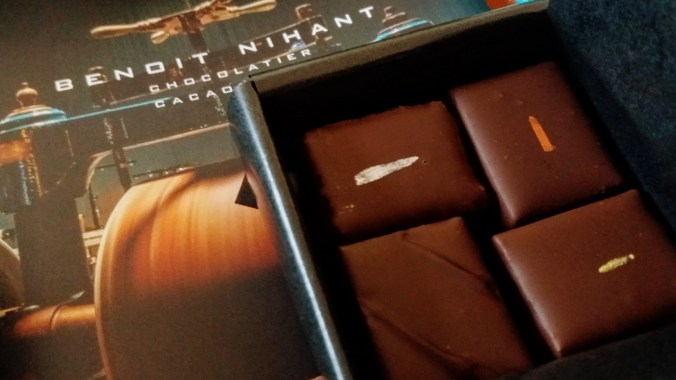 Earl Grey Ganache (two lines): This has a beautiful dark chocolate flavor, not acid or sweet, but earthy with a slight astringency from the tea. The bergamot is subtle, but it’s still a delightful piece.
Earl Grey Ganache (two lines): This has a beautiful dark chocolate flavor, not acid or sweet, but earthy with a slight astringency from the tea. The bergamot is subtle, but it’s still a delightful piece.
Orange Thyme (orange line): It has abright zest flavor, without being too citrusy. The thyme is subtle but ads depth and range to the flavor I don’t think you’d get with just the orange alone. The chocolate is still amazing.
Cuyagua Village Single Origin from Venezuela (gold line): Just so good. Intense chocolate flavor smooth and clean with a tiny hint towards the fruity but just a whisper to make it interesting. Light and bright, but strong and powerful. The ganache is smooth and dense and helps spread the flavor access the tongue. Much love. Single origin is meant to highlight the unique flavor of a region rather than other ingredients.
4 Spice Praline (silver line): I was told this was classic gingerbread spices. Definitely true. The praline had a nice crunch and crisp with a lovely gingerbread flavor. Not too sweet, beautiful classic chocolate, the spices are there but quiet. It’s a classy candy.

I loved Benoit Nihant so much that I hunted down their shop in Leige when I was there later in my trip. The weather was so hot that my chocolates melted a bit on the boat ride, so the textures were impacted by that, but it was still a trancendant experience.
Haceinda Single Origin: This one was dark and creamy, fruity without being overly acidic, with a slight spicy finish. Bear in mind, all that complexity comes from the chocolate alone, since there are no fruits or spices added. It’s a little like wine tasting.
Marzipan Pistachio: Since the original was so good, I decided to try the 2.0. It’s still delicious, but a bit sweeter. There is clearly a diffusion or mixture that isn’t all almond, I would not have been able to say it was pistachio if no one told me. Really good marzipan. I think I’ll stick to the original if I ever get another chance.
Peanut Praline: It’s like the most sophisticated peanut butter cup you’ll ever eat. It walks straight up to the edge of burnt sugar, bringing bitter, salty, sweet, and peanut in with the chocolate together with a nice crunch.
Hazelnut Praline: Surprisingly not as good as the peanut. It still has a dark close to burnt caramel in the praline. I can’t tell if the texture was off because of the melting but it seemed a bit more granular than it should be.
Lavender Ganache: Wow! Good lavender flavor without being potpourri. I love florals but balance is hard. I had become disenchanted with the violet ganaches in other shops and interrogated the shop staff mercilessly about this, but they nailed it!
Mint Ganache: This transported me back to my mother’s garden. The mint flavor is so fresh and natural I can taste the green. I believe it must have been made with fresh leaves in the infusion and not an extract.
Lime with Basil: The lime is dominant and reminds me of a lime chiffon or even a key lime pie, more like a creamy pastry lime than a drinks lime. The basil is a bit lost. Like the orange thyme, I think it added depth without drawing attention to itself.

The staff in both places were pleased to talk endlessly about the chocolates and the shop. In Leige there is also a cafe next to the chocolate shop that sells several chocolate deserts as well as chocolate drinks. I didn’t get a chance to try anything on that side, sadly. I also learned that you don’t actually have to get a box for 5€. If you buy the chocolates in a bag it’s 100g for 9€, which works out to about 15 chocolates, but there is no minimum.
5 stars: I wish everyone on a chocolate tour of Brussels could take a side trip out here or find one of the other 5 stores in Belgium as they are not available anywhere else and are truly a treat worth having. Try anything, but especially the marzipan.
Galler

Finally, I didn’t find this brand in a fancy shop in Sablon, but in nearly every grocery shop in the city. Galler praline bars were definitely a great score. They’re quite affordable and far superior to the average supermarket chocolate bar. Stop in a Del-Haize and grab your favorite flavor.
4 stars: Compared with the very best in Sablon, it might be 3, but taken in the context of the supermarket aisle, it blows away the competition.
Chocolate with Compassion
 Chocolate is one of my favorite things on Earth, however it is an industry rife with slavery and abuse. Cocoa only grows in a few places on the planet and those are almost exclusively in 3rd world, developing nations in Central & South America, as well as Africa. Cheap chocolate companies use child labor, forced labor, and under paid labor, putting vulnerable people at risk and taking advantage of the economic disparity between developed and developing nations.
Chocolate is one of my favorite things on Earth, however it is an industry rife with slavery and abuse. Cocoa only grows in a few places on the planet and those are almost exclusively in 3rd world, developing nations in Central & South America, as well as Africa. Cheap chocolate companies use child labor, forced labor, and under paid labor, putting vulnerable people at risk and taking advantage of the economic disparity between developed and developing nations.
In recent years, more and more fine chocolatiers have become interested in supporting these cocoa farmers by paying a fair price for this very labor intensive product. I often hear excuses about ethical consumerism around the basis of “all the companies do it”, or “how else am I supposed to afford xyz?”, but chocolate is a luxury and there are plenty of companies that source their cocoa responsibly.
Buying ethically sourced chocolate not only feels better, it often tastes better since these companies would not dream of diluting their top dollar cocoa with milk-fat, sugar, paraffin or other additives commonly used by the check-out aisle candy companies.
Please choose one of these the next time you want to indulge. Look for a label: Fair Trade, Fairly Traded, Jane Goodall, Fair for Life, Rainforest Alliance, UTZ. You can see a list of many slavery-free chocolate companies at this website. Small chocolatiers are not listed, so if you have a neighborhood chocolatier, you can always ask them. People who use ethically sourced cocoa are proud to tell you.
Happy eating!
Writing about chocolate has helped take the edge off of the sheer horror that is the US News Cycle this week. I can’t say chocolate makes it all better, but there is a certain amount of truth in J.K. Rowling’s assessment that chocolate helps in the battle against the Dark Arts. I will treasure this memory for as long as I have taste-buds, and I hope that you didn’t drool too much reading it 😉
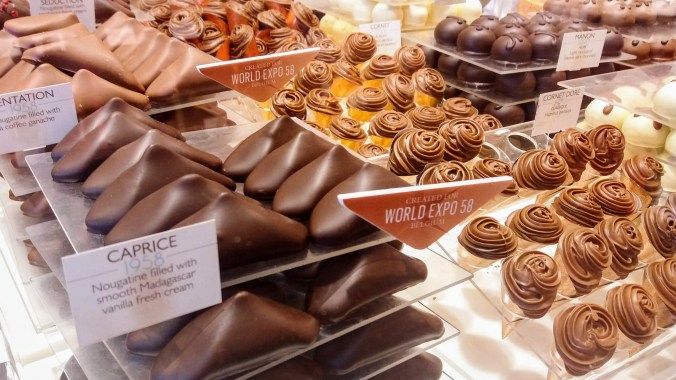


 Plan?
Plan? 

















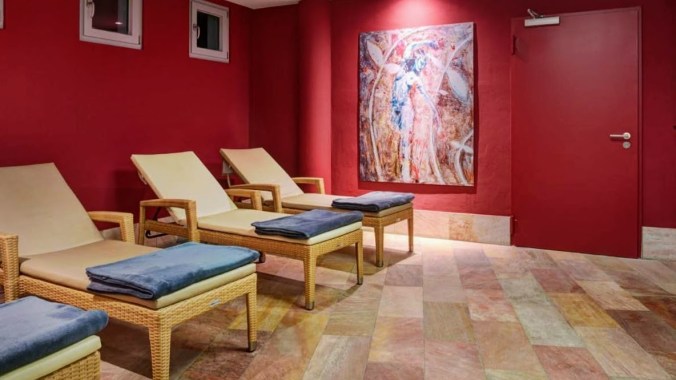





 You know that blast of heat you get when you open the oven to check on something? It was like that. The force of the hot air hitting us dead on as he went around the room. People put their arms up like in a roller coaster.
You know that blast of heat you get when you open the oven to check on something? It was like that. The force of the hot air hitting us dead on as he went around the room. People put their arms up like in a roller coaster.
 It’s a dry sauna meant to be like a red brick oven which is not uncommon in saunas. I’ve seen several in the Jimjilbang in Korea. However at Carolus, there’s actually an oven inside. Although the room is open for use all the time, every couple hours they bake something in the oven while people are there. I read about it before going and it was one of the things I was most looking forward to. I went into the room the same time the dough did and I lay in the semi-dry heat (60°C 40% humidity) dripping sweat and surrounded by the wonderful smell of fresh baking bread. I can’t even properly describe this room other than to say I felt like I was in the oven with the bread…in a really yummy way, not in a gingerbread cottage witch way.
It’s a dry sauna meant to be like a red brick oven which is not uncommon in saunas. I’ve seen several in the Jimjilbang in Korea. However at Carolus, there’s actually an oven inside. Although the room is open for use all the time, every couple hours they bake something in the oven while people are there. I read about it before going and it was one of the things I was most looking forward to. I went into the room the same time the dough did and I lay in the semi-dry heat (60°C 40% humidity) dripping sweat and surrounded by the wonderful smell of fresh baking bread. I can’t even properly describe this room other than to say I felt like I was in the oven with the bread…in a really yummy way, not in a gingerbread cottage witch way.
 The guide explained a bit about the history of early self playing music starting with bells and pipes. Bells were the first and “easiest”, if that can be applied to such complex machinery. A metal cylinder like that in a music box was used to orchestrate a series of springs and levers to tap small bells of different tones. There was only one length of note and it resulted in some very un-nuanced music, but the Victorians loved gadgets sooo much that owning such a marvel in one’s home was a real status symbol. They were incredibly expensive and very fine. The only way to change the song was to change the cylinder inside.
The guide explained a bit about the history of early self playing music starting with bells and pipes. Bells were the first and “easiest”, if that can be applied to such complex machinery. A metal cylinder like that in a music box was used to orchestrate a series of springs and levers to tap small bells of different tones. There was only one length of note and it resulted in some very un-nuanced music, but the Victorians loved gadgets sooo much that owning such a marvel in one’s home was a real status symbol. They were incredibly expensive and very fine. The only way to change the song was to change the cylinder inside.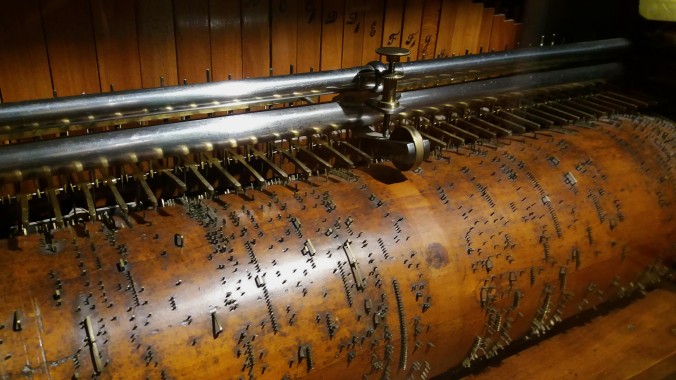
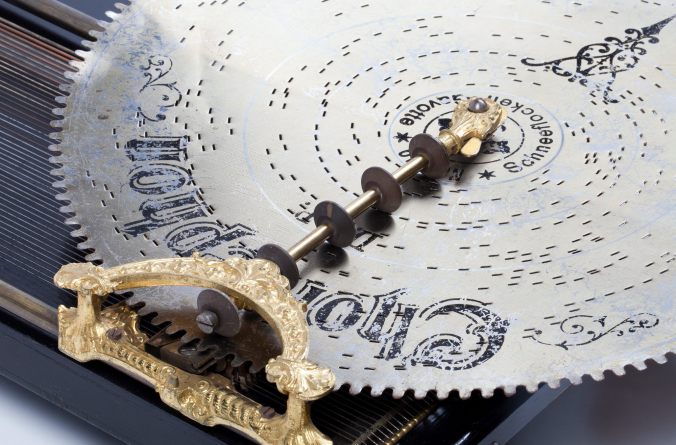


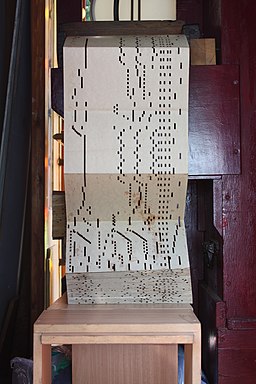


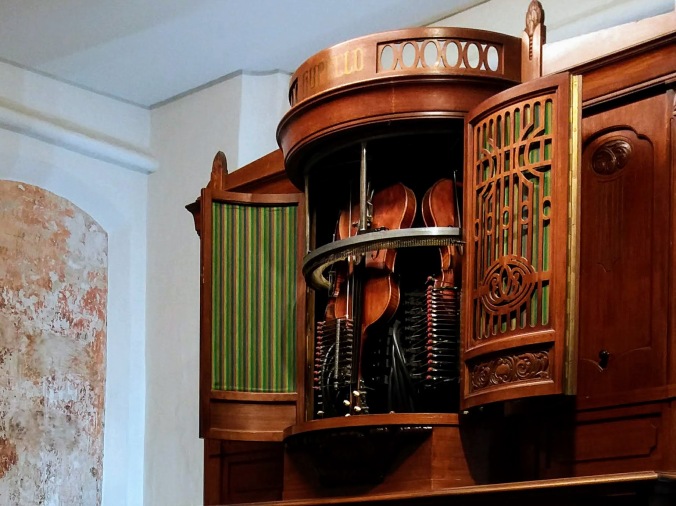 While the musical clock and player piano might find their way into any reasonably affluent household, the larger organs and orchestral players were reserved for the ultra wealthy and of course, the dance halls. During their height (again an incredibly brief time ending abruptly in 1930) these orchestrions were the darling of the day, drawing large crowds to dance halls to cut a rug to the mechanical orchestras and marvel at the wonders of modern technology. Because of the limited amount of musical numbers available to each machine, and because of the stunning but stationary artwork on the outside, audiences became bored with a single orchestrion quite quickly. (no, our attention spans weren’t any better a century ago no matter what your grandmother says) To keep the crowds coming, these huge machines were often built to be easily disassembled and moved to play a new dance hall every week. Early 20th century DJs played the precursor to EDM– MDM: Mechanical Dance Music.
While the musical clock and player piano might find their way into any reasonably affluent household, the larger organs and orchestral players were reserved for the ultra wealthy and of course, the dance halls. During their height (again an incredibly brief time ending abruptly in 1930) these orchestrions were the darling of the day, drawing large crowds to dance halls to cut a rug to the mechanical orchestras and marvel at the wonders of modern technology. Because of the limited amount of musical numbers available to each machine, and because of the stunning but stationary artwork on the outside, audiences became bored with a single orchestrion quite quickly. (no, our attention spans weren’t any better a century ago no matter what your grandmother says) To keep the crowds coming, these huge machines were often built to be easily disassembled and moved to play a new dance hall every week. Early 20th century DJs played the precursor to EDM– MDM: Mechanical Dance Music.
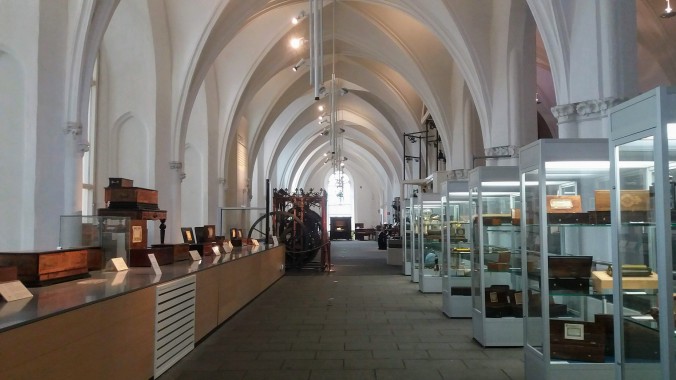
 The walls, columns, arches, and decorative carvings are painted a crisp clean white except a few places where the original church artwork has been preserved and painted around. The whitewashing isn’t a result of secularism, however, but rather the work of the Protestant reformation which took over the church in 1586 and just hated all that ostentatious Catholic art. Buurkirk was actively used as a church until 1975 and it became the Speelklok Museum in 1984. Wandering among the displays and whitewashed arches, my mind was occupied with the impending massive shift in my perception of humans, time, and technology.
The walls, columns, arches, and decorative carvings are painted a crisp clean white except a few places where the original church artwork has been preserved and painted around. The whitewashing isn’t a result of secularism, however, but rather the work of the Protestant reformation which took over the church in 1586 and just hated all that ostentatious Catholic art. Buurkirk was actively used as a church until 1975 and it became the Speelklok Museum in 1984. Wandering among the displays and whitewashed arches, my mind was occupied with the impending massive shift in my perception of humans, time, and technology.






